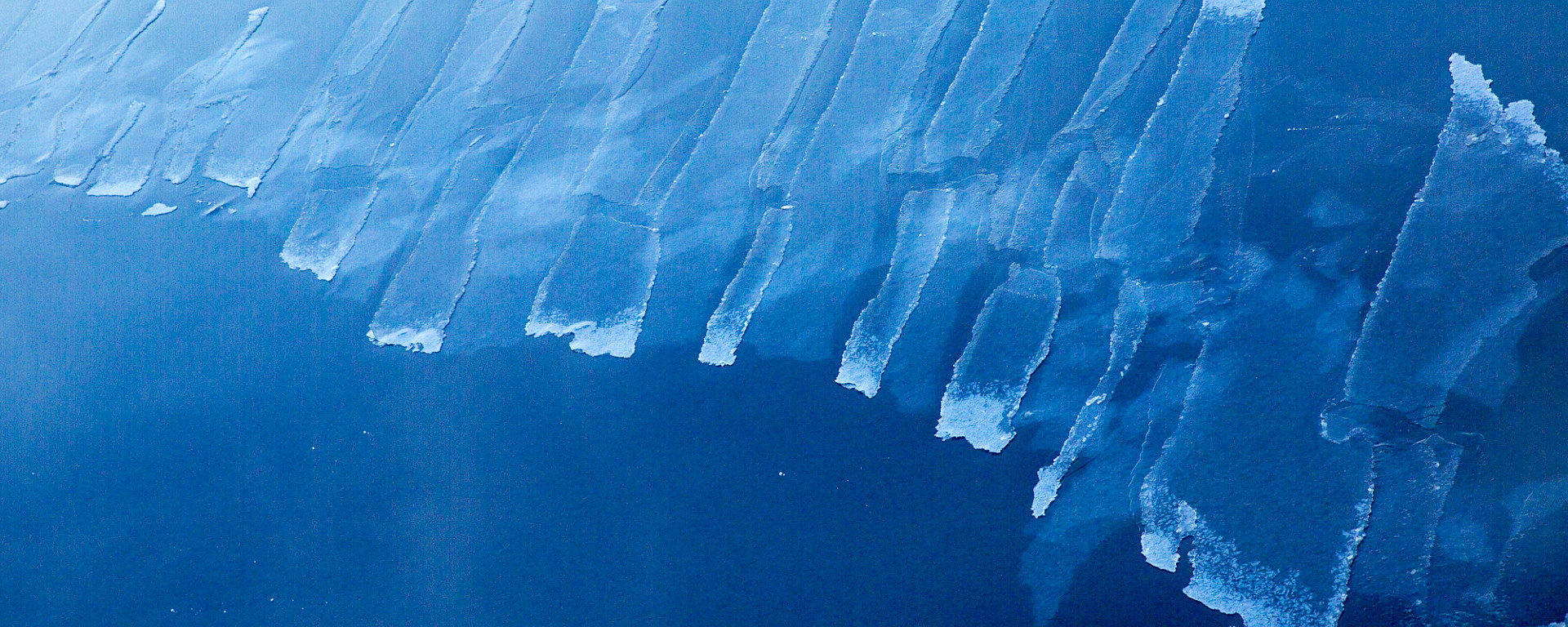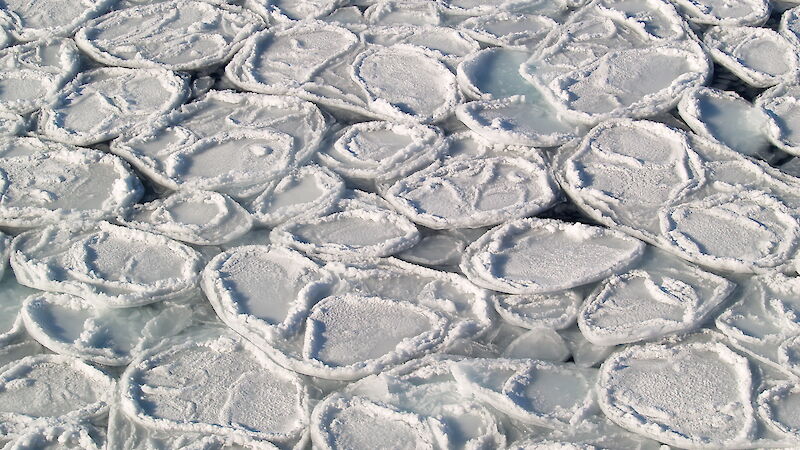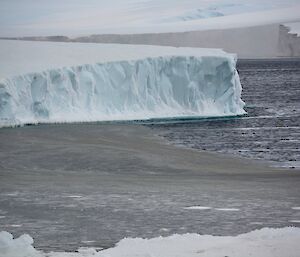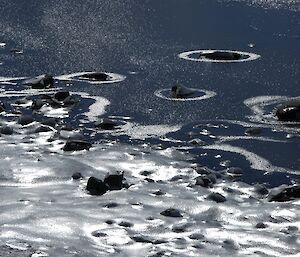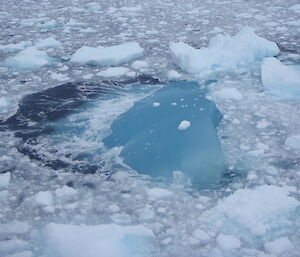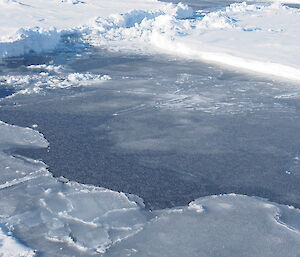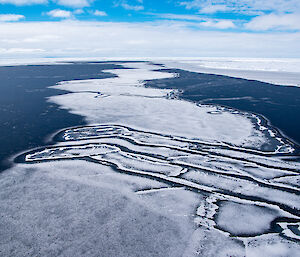New ice
New ice is a general term for ice that is recently formed. This includes frazil ice, grease ice, slush and shuga. These types of ice are composed of ice crystals, which are only weakly frozen together (if at all). They only have a definite form while they are afloat.
Frazil ice
Frazil ice forms fine spicules or plates of ice, which are suspended in the water. This is the first stage of sea ice growth. The frazil crystals are usually suspended in the top few centimetres of the surface layer of the ocean and give the water an oily appearance.
Grease ice
Grease ice is later stage of freezing than frazil ice. The crystals have coagulated to form a soupy layer on the surface. Grease ice reflects little light, giving the sea a matt appearance. Grease ice behaves in a viscous fluid-like manner, and does not form distinct ice floes.
Slush
Slush is snow that is saturated and mixed with water. It can be found on land or ice surfaces, or as a viscous floating mass in water after a heavy snowfall.
Shuga
Shuga is an accumulation of spongy white ice lumps, a few centimetres across. Shuga ice is formed from grease ice or slush and sometimes from anchor ice rising to the surface.
Nilas
Nilas is a thin, elastic crust of ice, easily bending on waves and swell and under pressure, thrusting in a pattern of interlocking ‘fingers’. It has a matt surface and is up to 10 cm in thickness. Nilas ice can be subdivided into dark nilas and light nilas.
Dark nilas
Dark nilas is under 5 cm in thickness and is very dark in colour.
Light nilas
Light nilas is more than 5 cm in thickness and is lighter in colour.
Ice rind
Ice rind is a brittle shiny crust of ice formed on a quiet surface by direct freezing or developing from grease ice. It usually forms in water of low salinity and reaches up to about 5 cm in thickness. Ice rind is easily broken by wind or swell, and commonly breaks into rectangular pieces.
Pancake ice
Pancake ice is made of predominantly circular pieces of ice, 30 cm to 3 m in diameter, and up to about 10 cm in thickness. The discs of ice have raised rims, created when the pieces strike against each other. Pancake ice may form on a slight swell from grease ice, shuga or slush, or as a result of the breaking of ice rind, nilas or — under severe conditions of swell or waves — of grey ice. It also sometimes forms at some depth at an interface between water bodies of different physical characteristics, from where it floats to the surface. Its appearance may rapidly cover wide areas of water.
Young ice
Young ice is the transition stage between nilas and first-year ice. Young ice ranges from 10 cm to 30 cm in thickness. It can be subdivided into grey ice and grey-white ice.
Grey ice
Grey ice is 10 cm to 15 cm thick. It is less elastic than nilas and breaks on swell. It usually rafts under pressure.
Grey-white ice
Grey-white ice is 15 cm to 30 cm thick. Under pressure it is more likely to ridge than to raft.
First-year ice
First-year ice is sea ice of not more than one winter’s growth. It develops from young ice and has a thickness of 30 cm to 2 m. First-year ice can be subdivided into thin first-year ice/white ice, medium first-year ice and thick first-year ice.
Thin first-year ice/white ice
Thin first-year ice/white ice is 30 cm to 70 cm thick. It is 30 cm to 50 cm thick in its first stage, and 50 cm to 70 cm thick in its second stage.
Medium first-year ice
Medium first-year ice is 70 cm to 120 cm thick.
Thick first-year ice
Thick first-year ice is over 120 cm thick.
Old ice
Old ice is sea ice that has survived at least one summer’s melt. It is typically up to 3 m or more in thickness. Most topographic features are smoother than on first-year ice. Old ice can be subdivided into residual, second-year ice and multi-year ice.
Residual ice
Residual ice is first-year ice that has survived the summer’s melt and is now in the new cycle of growth. Its thickness ranges from 30 cm to 180 cm. After 1 July, this ice is called second-year ice.
Second-year ice
Second-year ice has survived only one summer’s melt. It is typically up to 2.5 m thick, and sometimes more. Because it is thicker than first-year ice, it stands higher out of the water. Summer melting produces a regular pattern of numerous small puddles. Bare patches and puddles are usually greenish-blue.
Multi-year ice
Multi-year ice has survived at least two summers’ melt. It is up to 3 m or more in thickness. Hummocks (hillocks of broken ice that have been forced up by pressure) on multi-year ice are even smoother than in second-year ice. The ice is almost salt-free. Colour, where bare, is usually blue. Melt pattern consists of large interconnecting irregular puddles and a well-developed drainage system.

